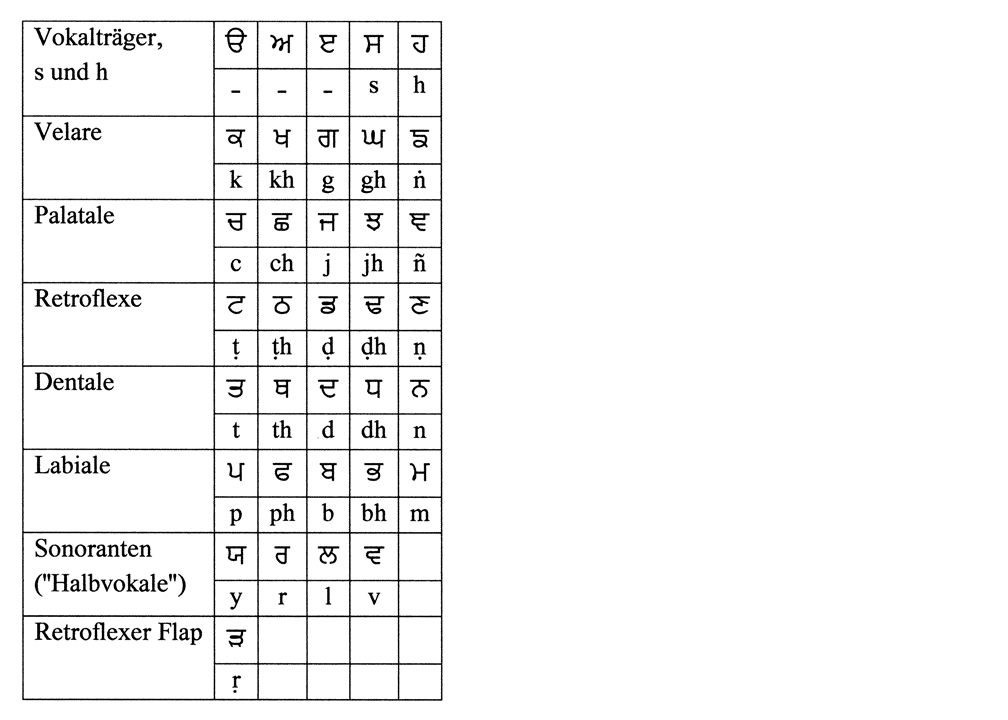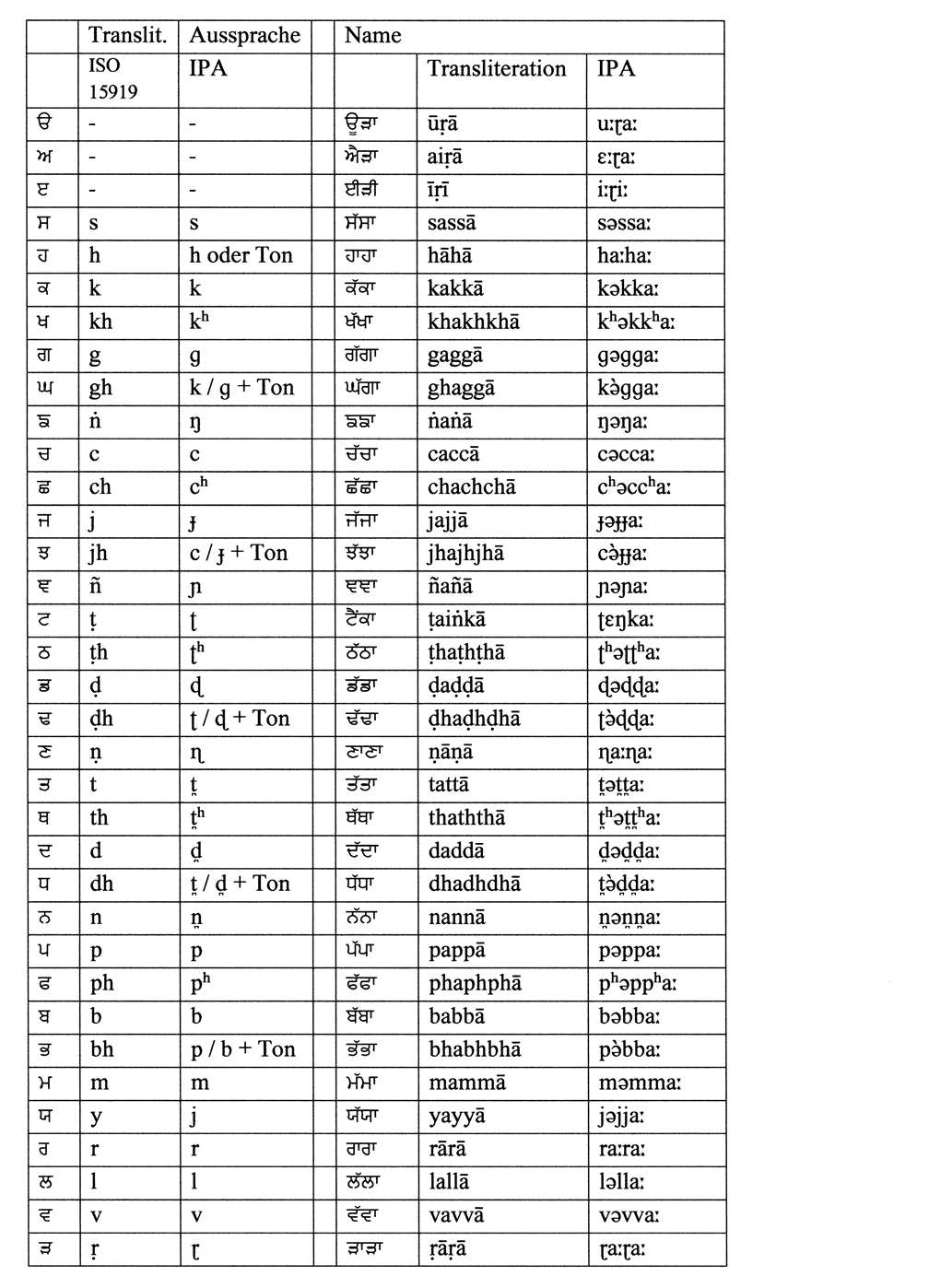Gurmukhi script
| Gurmukhi | ||
|---|---|---|
 ka in Gurmukhi |

|
|
| Font | Abugida | |
| languages | Punjabi | |
| Used in | Panjab | |
| ancestry |
Protosinaitic script → Phoenician script → Aramaic script → Brahmi script → Gurmukhi |
|
| particularities | Belongs to the Indian font family. | |
The Gurmukhi script (ਗੁਰਮੁਖੀ gurmukhī ) is used to write punjabi . It belongs to the Indian group of scripts , that is to say to the scriptures derived from the Brahmi script . Typologically it is an Abugida .
history
The name Gurmukhi is derived from ਗੁਰੂ gurū "teacher" and ਮੁਖ mukh "mouth".
The Gurmukhi script developed from the Brahmi script and is similar to the scripts common in northern India such as Devanagari and Gujarati . It received its present form in the 16th century from Guru Angad Dev , the second Guru of the Sikhs.

Text example
(from C. Shackle: Punjabi, Teach Yourself Books, London 1972)
Translation (after Shackle)
I was amazed that the Transport Committee banned the Sikhs from wearing turban, especially when it did not force its other conductors and drivers to wear their uniforms properly. We were told that the hat would not be handed out with the uniform unless someone specifically asked for it.
particularities
The Gurmukhi script differs significantly from all other Brahmi descendants in some points . This applies in particular
- the alphabetical order, which differs significantly from all other scripts in the Indian writing group ,
- the almost complete absence of ligatures .
The notes of punjabi are indicated in the scriptures.
Character inventory
The order of the characters does not correspond to the order of the Gurmukhi alphabet (see below!). The order of the Devanagari alphabet was chosen to facilitate comparison within the Indian scriptures .
Under the Gurmukhi symbols, the corresponding Devanagari symbols and the Latin transliteration according to ISO 15919 are given.
Vowels
In the case of the vowels , the first thing you notice is the lack of syllabic consonants . In contrast to Hindi and other New Indian languages , the associated characters were not retained. Phonetically, the syllable r in Punjabi has become [rɪ] (as in Hindi) or [ɪr].
Examples (Hi. = Hindi; Pa. = Punjabi):
The vowel symbols can be divided into 3 groups according to their graphic form, each of which has the same vowel carrier to which the corresponding vowel diacritic (see below!) Is added:
- ੳ called "ūṛā" for ‹u› and ‹ū› (graphically related to Devanagari उ), derived from this ਓ for ‹o›
- ਅ called "aiṛā" for ‹a›, ‹ā›, ‹ai› and ‹au› (graphically related to Devanagari अ)
- ੲ called "īṛī" for ‹i›, ‹ī› and ‹e› (graphically related to Devanagari ए)
The Punjabi alphabet (see below) begins with these vowel carriers in the order shown here (!).
Additional characters
(A placeholder should be visible for the respective letter, for example a dashed circle.)
- Tippi ੰ
- Bindi ਂ
- Adhak ੱ
Tippi and Bindi denote the nasalization of vowels and homorganic nasals in front of the corresponding consonants . Adhak indicates that the following consonant is long (" geminated ").
Consonants
[ʂ] has become [kʰ] in Punjabi. With that the character for [ʂ] (Gurmukhi ਖ, Devanagari ष ‹ṣ›) has moved into the alphabetical position of ‹kh›.
Example:
/ ɕ / and / s / are in Panjabi collapsed to / b /.
As in other North Indian scripts , a point below ("Nukta") is often used as a diacritic to expand the character set .
Vowel diacritics
As in other Abugidas , the Gurmukhi script consonant signs have an inherent vowel. It is transliterated as ‹a› and pronounced [ə]. In contrast to all other scripts in use in India, its absence is not marked graphically. Virama (Halant) is only occasionally used when writing Sanskrit . This makes the spelling of Punjabi much less clear than that of other Indian scripts .
For the other vowels are Vokaldiakritika used:
The following convention applies to the use of bindi and tippi to denote the nasalization of vowels :
Adhak
A special feature of the Gurmukhi script is a diacritic for consonant length ( gemination ). It is called Adhak (ਅਧਕ ‹adhak› [ə́dək]) and stands above the end of the spelling syllable that precedes the consonant to be lengthened. Numerous examples of this can be found in the following list of names and pronunciation of the letters.
Alphabetical order
The Gurmukhi alphabet is called Ura-Aira (ਊੜਾ ਐੜਾ ‹ūṛā aiṛā› [uːɽaː ɛːɽaː]) after the names of the first two letters.
The alphabetical order of the Gurmukhi script differs greatly from that of all other scripts in the Indian alphabet . This applies particularly to the order of the vowels .
At the beginning of the alphabet are the three vowel carriers, followed by ‹s› and ‹h›. The "core area" of plosives and sonorants was retained . At the end there is the retroflex flap ‹r›.
Therefore, a Punjabi dictionary begins with the independent vowels in the order of the vowel carriers, thus: u ū oa ā ai au i ī e. In contrast to this, the vowel diacritics are arranged in the "normal" order of the other Indian scripts , ie: a ā i ī u ū e ai o au.
but:
Tippi, Bindi, Adhak and the point below are ignored in the alphabetical order!
Names and pronunciation of the letters
The letters of the Gurmukhi alphabet are named and pronounced as follows:
Consonant ligatures
Consonant ligatures hardly appear in the Gurmukhi script any more. Only ‹ya›, ‹ra›, ‹va› and ‹ha› as the second components of a group of two consonants take on special forms:
The special forms of ‹ya› and ‹va› are rarely used.
Instead of the signed version of ‹ra›, the normal form is often used without the preceding consonant being marked as vowelless. In the dictionary you can often find both spellings next to each other. The same pronunciation is usually given for both:
In contrast to all other North Indian scripts, there are no diacritics in Gurmukhi to mark groups of consonants (such as the “Reph” in Sanskrit, see Indian Writing Circle ).
The most important special character is the signed ‹ha›. It is usually not pronounced, but serves as a diacritic to designate tones in words that do not contain voiced aspirated plosives or a 'ha'. Strictly speaking, the combination "consonant + signed ‹ha›" can no longer be called a ligature, especially since the signed ‹ha› can also be placed under a vowel carrier:
orthography
In the Gurmukhi script, in contrast to most of the other modern scripts of the Indian group of scripts, a large part of the historical spellings have been adapted to the state of the contemporary language ( Punjabi ). This applies in particular to:
- Omission of symbols for syllabic consonants ,
- Most ligatures and the absence of Virama (Halant) are omitted,
- Diacritic for consonant length ,
- In the pronunciation omission of aspiration (at the beginning of the word also voicing) of voiced plosives connected with high or low tone of the syllable carrying the word accent ,
- in the pronunciation partial omission of [h] (except at the beginning of the word) combined with high or low tone of the syllable carrying the word accent ,
- Signed “ha” as a diacritic to denote tones .
The spelling does not clearly indicate whether the inherent vowel / a / is spoken or not. It would be clear either to use Halant for lack of vowels or to introduce a diacritic for / a /.
Signed ‹ra› does not always mean that the consonant above is spoken without a vowel. Therefore, there are also spelling variants here (see above!).
Marking of tones
When viewed synchronously , one can say that the symbols for the aspirated voiced plosives serve to mark tones . Overall, the tones of punjabi can be graphically marked in the Gurmukhi script as follows:
As a rule, a word can only contain one tonal syllable . This is always the syllable that carries the word accent . However, this is not labeled graphically. Depending on the position of the word accent and the tone marking, a high tone or a low tone is spoken. The following rule applies here:
- Word accent after tone marking → low tone
- Word accent before tone marking → tweeter
All unstressed syllables and all syllables of words without a tone mark are spoken in a medium pitch.
Examples (Tone markings are printed in bold in the transliteration (‹...›). [´] = high tone; [`] = low tone.)
Comparison of the Gurmukhi script with the neighboring Devanagari
At first glance, the Gurmukhi script seems to be very similar to Devanagari . On closer inspection, however, there are sometimes considerable differences. For example, if you can Devanagari and want to learn Gurmukhi, you have to beware of "false friends" (misleading similarities).
A comparison of the two fonts is shown in the tables on the number of characters (see above!).
Gurmukhi digits
Gurmukhi in Unicode
Unicode for Gurmukhi is U + 0A00… U + 0A7F.
| 0 | 1 | 2 | 3 | 4th | 5 | 6th | 7th | 8th | 9 | A. | B. | C. | D. | E. | F. | ||
| A00 | ਁ | ਂ | ਃ | ਅ | ਆ | ਇ | ਈ | ਉ | ਊ | ਏ | |||||||
| A10 | ਐ | ਓ | ਔ | ਕ | ਖ | ਗ | ਘ | ਙ | ਚ | ਛ | ਜ | ਝ | ਞ | ਟ | |||
| A20 | ਠ | ਡ | ਢ | ਣ | ਤ | ਥ | ਦ | ਧ | ਨ | ਪ | ਫ | ਬ | ਭ | ਮ | ਯ | ||
| A30 | ਰ | ਲ | ਲ਼ | ਵ | ਸ਼ | ਸ | ਹ | ਼ | ਾ | ਿ | |||||||
| A40 | ੀ | ੁ | ੂ | ੇ | ੈ | ੋ | ੌ | ੍ | |||||||||
| A50 | ੑ | ਖ਼ | ਗ਼ | ਜ਼ | ੜ | ਫ਼ | |||||||||||
| A60 | ੦ | ੧ | ੨ | ੩ | ੪ | ੫ | ੬ | ੭ | ੮ | ੯ | |||||||
| A70 | ੰ | ੱ | ੲ | ੳ | ੴ | ੵ | ੶ | ||||||||||
literature
- Mangat Rai Bhardwaj: Colloquial Punjabi. London 1995, ISBN 0-415-10191-3 .
- Mukhtiar Singh Gill, SS Joshi (Ed.): Punjabi-English Dictionary. Patiala (India) 1994, ISBN 81-7380-096-0 .
- GA Grierson: Linguistic Survey of India. IX, 1916. (Reprint Delhi 1968)
- Colin P. Masica: The Indo-Aryan Languages. Cambridge 1991, ISBN 0-521-23420-4 .
- C. Shackle: Punjabi. Teach Yourself Books, London 1972, ISBN 0-340-12464-4 .
- Elvira Friedrich: Introduction to the Indian Scriptures. Part 2: Gujarati, Gurmukhi, Bengali, Oria . Buske, Hamburg 2002, ISBN 3-87548-219-0
















